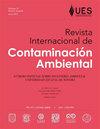壳聚糖基纳米洋葱的制备与表征
IF 0.4
4区 环境科学与生态学
Q4 ENVIRONMENTAL SCIENCES
引用次数: 0
摘要
这项工作介绍了以纳米洋葱形式与卵磷脂交联的壳聚糖纳米颗粒的形态和表征,该纳米颗粒是通过一种简单、经济且可能可扩展的方法从一种称为壳聚糖的聚合物前体中获得的。利用虾渣生产新产品是避免水污染的一个基本因素。这些材料具有积极的影响,因为它们增加了废物的价值,并为减少污染提供了机会。以壳聚糖为天然原料,采用环保、简便、廉价的方法合成了壳聚糖纳米洋葱。采用傅立叶变换红外光谱(FTIR)、X射线衍射(XRD)、扫描电子显微镜(SEM)、透射电子显微镜(TEM)、动态光散射(DLS)和比表面积(SSA)对壳聚糖纳米洋葱(CSNO)进行了表征。通过FTIR获得的纳米洋葱表征显示,在1752.12 cm–1的波数下存在羰基,而在1156.88 cm–1处观察到卵磷脂的磷酸基团。XRD分析证实了无定形结构,而SEM图像呈现出具有凹面的球状形态。TEM分析表明,纳米洋葱聚集在一个独特的结构中,其中包括纳米管。DLS测得的CSNO平均直径为442.5 nm,呈八边形排列,多分散指数(PDI)为0.532和31.9 mV。CSNO的平均尺寸、PDI和ζ电位值是稳定分散体的指标,通过Brunauer-Emmett-Teller(BET)法测得的比表面积为1.4 m2 g–1。壳聚糖-卵磷脂纳米洋葱的表征结果表明,与纯壳聚糖相比,该材料的表面发生了变化,具有更大的总表面积和孔结构。根据CHNO的表征结果,它们可以用作污染物的吸附剂,在生物医学领域也有潜在的应用,主要是作为药物包封材料。本文章由计算机程序翻译,如有差异,请以英文原文为准。
Nano-onions based on chitosan: Production and characterization
This work presents the morphology and characterization of chitosan nanoparticles crosslinked with lecithin in the form of nano-onions obtained by an easy, economical, and possibly scalable method from a polymeric precursor known as chitosan. The creation of new products by using shrimp waste is a fundamental factor in avoiding water pollution. These materials have a positive impact as they add value to waste, and they provide the opportunity to decrease pollution. Chitosan nano-onions were synthesized by an environmentally friendly, easy, and inexpensive method using chitosan as a natural source. Chitosan nano-onions (CSNO) were characterized by using Fourier transform infrared spectroscopy (FTIR), X-ray diffraction (XRD), scanning electron microscopy (SEM), transmission electron microscopy (TEM), dynamic light scattering (DLS) and specific surface area (SSA). The nano-onions characterization obtained by FTIR shows the presence of carbonyl groups at a wavenumber of 1752.12 cm–1, while the phosphate groups attributed to lecithin are observed at 1156.88 cm–1. XRD analysis confirmed an amorphous structure, while SEM images presented a globular morphology with concave surfaces. TEM analysis showed that the nano-onions are congregated in a unique structure that includes nanotubes. The CSNO average diameter by DLS was 442.5 nm with an octagonal arrangement, and a polydispersity index (PDI) of 0.532 and 31.9 mV. The average size of CSNO, the PDI, and the value of zeta potential were indicators of a stable dispersion with a specific superficial area measured by the Brunauer-Emmett-Teller (BET) method of 1.4 m2 g–1. The results of the chitosan-lecithin nano-onions characterization indicate changes in the surface of the material with a larger total surface area and pore structure, compared to that of pure chitosan. According to the results of the CHNO characterization, they could be used as adsorbents for contaminants and they also have a potential application in the biomedical area, mainly as drug encapsulation material.
求助全文
通过发布文献求助,成功后即可免费获取论文全文。
去求助
来源期刊

Revista Internacional De Contaminacion Ambiental
ENVIRONMENTAL SCIENCES-
CiteScore
0.90
自引率
16.70%
发文量
59
期刊介绍:
En esta revista se aceptan para su publicación trabajos originales y de revisión sobre aspectos físicos y químicos de la contaminación, investigaciones sobre la distribución y los efectos biológicos y ecológicos de los contaminantes; así como sobre tecnología e implementación de nuevas técnicas para su medida y control; también son aceptados estudios sociológicos, económicos y legales acerca del tema. Se publicarán los escritos que mediante arbitraje de especialistas y a juicio del Consejo Editorial tengan el nivel y la calidad adecuados para ello y su contenido será responsabilidad única de los autores. La Revista Internacional de Contaminación Ambiental es de periodicidad trimestral y se publica los días 1 de febrero, mayo, agosto y noviembre.
 求助内容:
求助内容: 应助结果提醒方式:
应助结果提醒方式:


